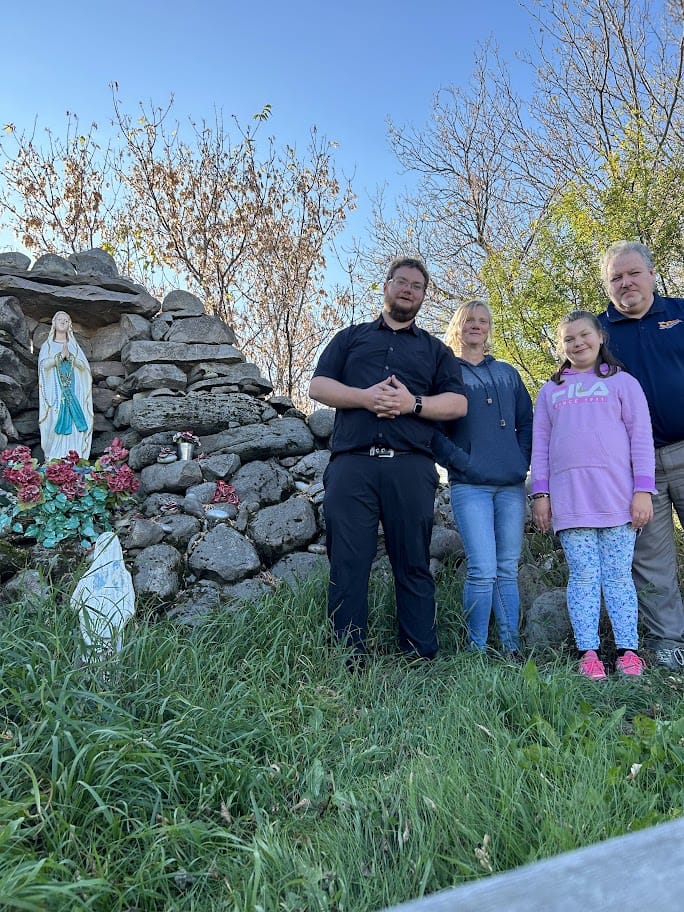
‘For the local church’
Thomas Wollis reflects on his pastoral internship in the mission community of Wabasca
Greetings! Or as we say in Cree, “Tansi!”
As some of you may already know, I have spent these past eight months on a pastoral internship at St. Martin Parish in Wabasca (roughly 140 kilometers northeast of Slave Lake & 180 kilometers northwest of Athabasca). Wabasca is a community of roughly 5,000 people spread across the Municipal District of Opportunity and the Bigstone Cree Nation.
Having completed my internship, I offer this reflection on both my experience this past year and my continued discernment.
While St. Martin Parish may not be the oldest church in our archdiocese, it is certainly one of the earliest and most historic missions in the region.
It was established by Fr. J.B. Giroux, OMI in 1897, when the original St. Martin Chapel was built. This chapel would later be knocked down in 1929 to make way for the construction of the new residential school buildings. St. Charles Church as well as St. Theresa’s School were later constructed from 1935-1936.
Not long after, St. Martin Church was rebuilt in 1957 and connected to St. Charles Church by way of a direct telephone line. This is the same St. Martin Church standing today, and by the early 2000’s, St. Martin’s would become the primary parish church in Wabasca.
Upon learning that I would be in such a historic and unique community for my internship, I was excited and also a bit nervous. Not only did I have little sense of what to expect, I had no idea where Wabasca even was. I had heard stories, seen signs for it, but had never been there. What would the people be like? What would I do? These questions ran rampart in my mind.

Shortly before I began my internship last September I attended St. Joseph Seminary’s opening retreat, preached by Bishop Stephen Hero.
During this retreat, each of us seminarians were asked to reflect on how the heart of a priest ought to be formed within the Sacred Heart of Christ. This would come to be increasingly important to me over my months in Wabasca.
Not long after this retreat, as I was preparing for my travels, I got a message from Sister Mary Jeanne Davidson SSND who helped put everything into perspective.
Sr. Mary Jeanne spent many years in our archdiocese working closely with the Indigenous peoples, particularly in places like Cadotte Lake, and she had much experience in pastoral care with First Nations communities. She wrote in her e-mail:
“How good God’s provident love is calling you to Internship in Wabasca! I will be praying for you and the people. You have been quietly gifted by the Spirit to truly trust your listening as you walk beside them and mutually grow in communion and love. It’s the little human encounters that build trust. And being in God’s presence, letting God’s love form you after his discipleship, will move the very heart of God in preparing you ‘to smell the sheep’ and become a shepherd after God’s own heart.”
It was these words of wisdom, combined with the advice of Fr Les Kwiatkowski, OMI, which helped shape my approach to ministry in Wabasca. Fr. Les had spent many years in the Archdiocese of Grouard-McLennan and was the former pastor for St. Martin Church in Wabasca. I decided to reach out to him personally for advice before I embarked on my internship.
Fr. Les emphasized to me that I must keep in mind that life in Wabasca is simple. Whether engaging in parish maintenance, attending community events, hunting and fishing with the locals, or helping someone change a tire – all of these things, while seemingly simple, are not only an important part of daily life in Wabasca, but they will also be a vital part of my ministry there.

One Sunday Mass, shortly after I arrived, Fr. Stanislaus Okonkwo and I made a short “pilgrimage” with a group of parishioners to the Marian shrine and grotto in Wabasca. While we walked back, an eagle flew overhead and landed beside us in the trees.
I was told by a handful of parishioners that the eagle was welcoming me to Wabasca, bringing with it blessings on the year (and work) to come. This was something I will admit I did not fully grasp, but as the year progressed, I soon realized the spiritual significance of the eagle to the Indigenous peoples of Wabasca. It is the eagle who carries offerings to the heavens, to the Creator.
Recognizing this, it became all the more powerful whenever I would see the majestic eagle soaring high above us, watching over as if it was a guide leading and beckoning me onward.

This is only an excerpt. Read the full story in the May 2024 edition of Northern Light
Article by Thomas Wollis